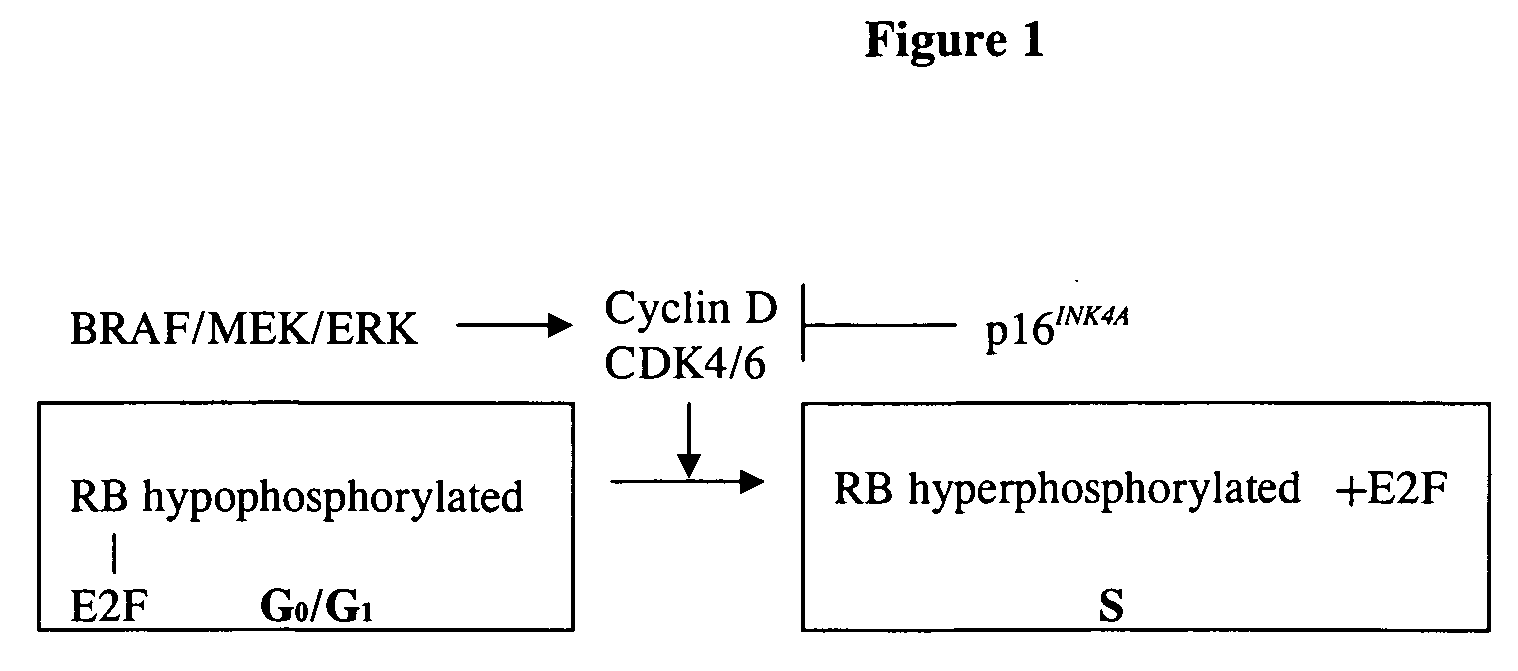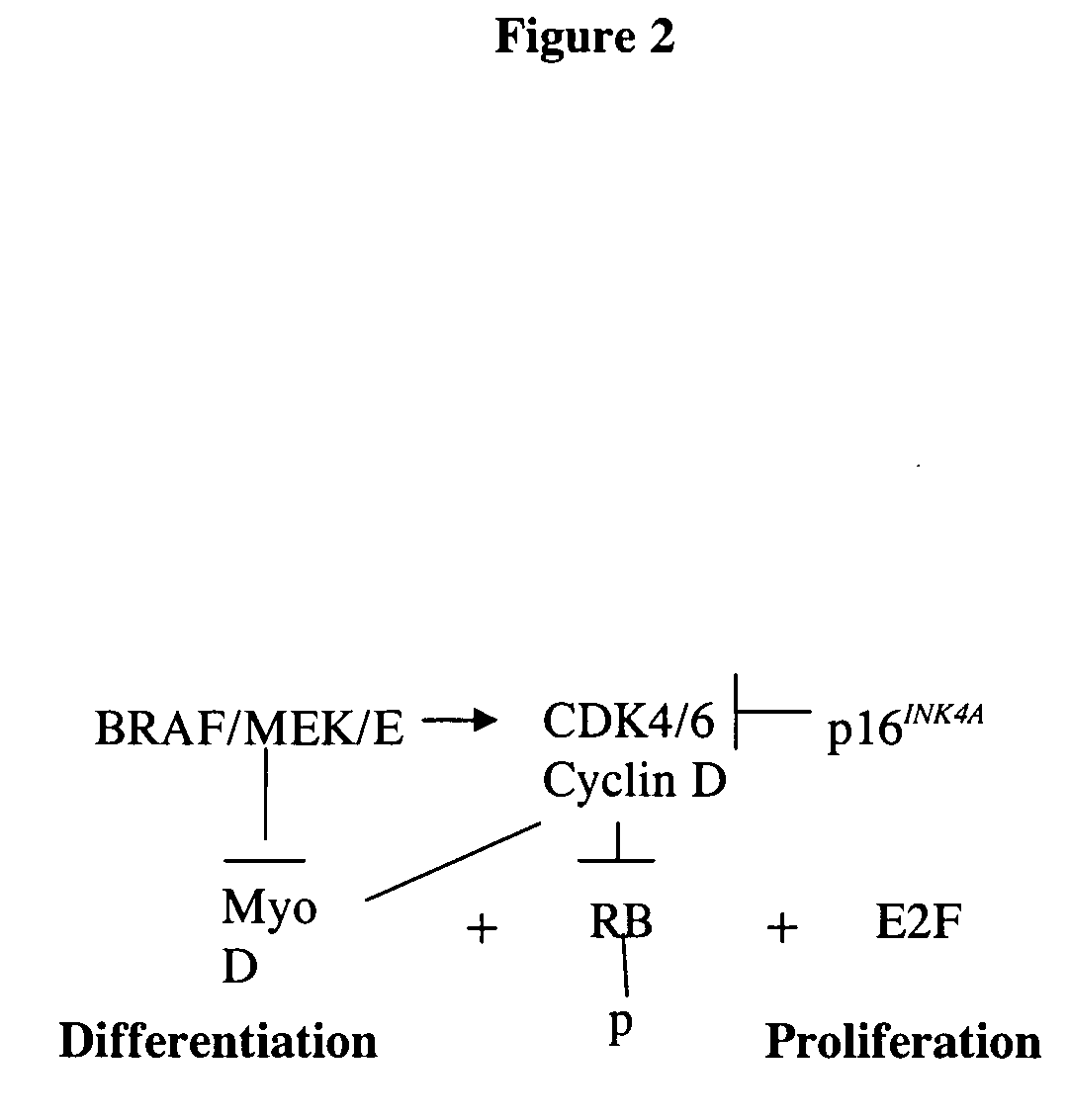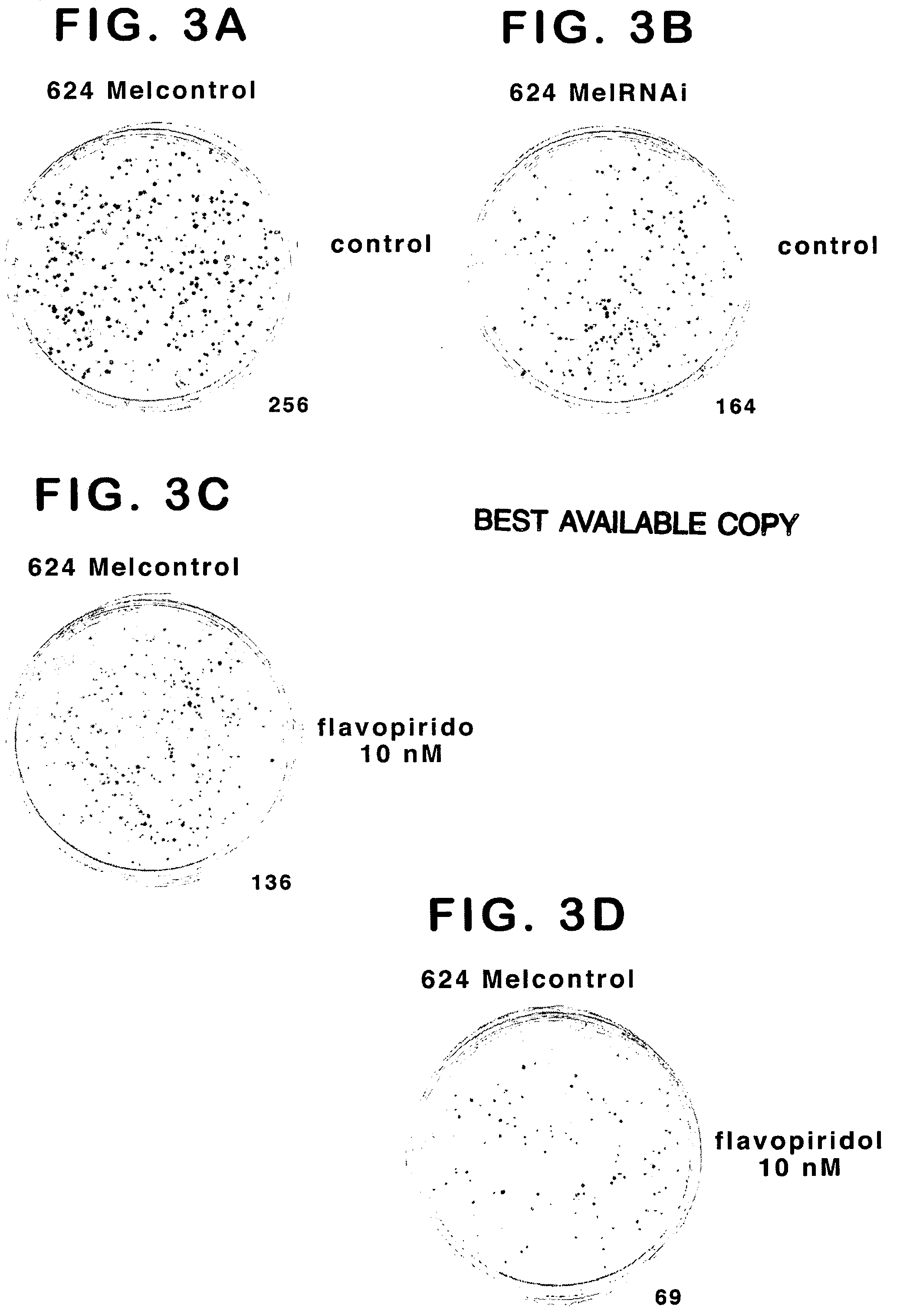Treatment of cancer by simultaneous inhibiton of BRAF and restoration or mimicry of p16INK4A activity
a cancer and simultaneous inhibition technology, applied in the direction of viruses/bacteriophages, biocide, genetic material ingredients, etc., can solve the problems of malignant transformation in nevus cells, no effective treatment, etc., and achieve the effect of restoring, increasing or mimicking the activity of a functional p16ink4a, inhibiting the growth of braf, and inhibiting the expression or activity of bra
- Summary
- Abstract
- Description
- Claims
- Application Information
AI Technical Summary
Benefits of technology
Problems solved by technology
Method used
Image
Examples
example 1
Inhibition of Oncogenic BRAF by RNAi
[0173] Rationale. 28 melanoma cell lines were screened for BRAF exon 15 mutations (Dong et al., Cancer Res. 2003; 63: 3883-3885). 22 cell lines were found to have a BRAF mutation (positive rate 79%). 20 of the mutations were at the hot spot T1796A transition. RNAi was then used to specifically inhibit the expression of the T1796A mutant BRAF (mBRAF). Specifically, a retroviral vector, pRETRO-SUPER-puro (pRS) (Brummelkamp et al., 2002, supra), which expresses the mBRAF RNAi as a short hairpin RNA (shRNA). The hairpin is cleaved by cellular factors to produce the mature RNAi (Agami, Curr Opin Chem Biol. 2002; 6:829-34.; Denli and Hannon, Trends Biochem Sci. 2003; 28:196-201).
[0174] The specificity and efficacy of the RNAi to knock down mutant BRAF expression was examined by (1) transient co-expression experiments in 293T cells, (2) comparison of changes of BRAF levels in BRAF wt and mutant LOH cells.
Results
[0175] Mutant BRAF RNAi reduced mBRAF ...
example 2
Restoration of p16 or Suppression of Oncogenic BRAF Retards Melanoma Cell Growth
[0176] RNAi was used to specifically inhibit the expression of the T1796A mBRAF using a retroviral vector, and INK4A cDNA was used to restore wt INK4A expression in melanoma cells harboring both mBRAF and lost of expression of wt p16INK4A. The data presented below is from combined studies.
Methods
BRAF
[0177] A retroviral vector, pRETRO-SUPER-puro (pRS-Brummelkamp et al., Cancer Cell. 2002(2):243-7) was used to generate control and mBRAF RNAi-expressing retroviruses, designated pRS-puro and pRS-puro mBRAF RNAi, respectively. The retroviruses were then used to infect a control melanoma cell line which expresses wt BRAF (Mel1363); an two melanoma cell lines that are heterozygous for mBRAF (624Mel and WM35), and one line exhibiting loss of heterozygosity and expressing only mBRAF (A375). Stable cell lines were generated after selection with puro and used in the subsequent assays. Cells were grown and lysed...
example 3a
Effects on Melanoma Cells of Combined Inhibition of Oncogenic BRAF and Restoration of wt p16INK4A
[0198] These experiments were performed to test the hypothesis that simultaneous inhibition of mBRAF and restoration of INK4A expression has a more potent effect against melanoma cells than inhibition of mBRAF or restoration of INK4A alone.
Methods
[0199] Control cells and cells stably already expressing mBRAF RNAi were infected with control (pBabe-neo) or INK4 (pBabe-neo-INK4A) retroviruses as described above. G418 (geneticin plus puro) was used as a selection agent for transfection. The experiments were performed using 624Mel and WM35 melanoma cells, both of which harbor BRAF mutation and INK4A mutation / deletion. Mel1363 melanoma cells, which are BRAF wt and express low-level, wt INK4A, were used as control.
[0200] The mBRAF RNAi and INK4A co-expression experiment was then performed in the reverse order (infect INK4A expressing cells with mBRAF RNAi) (Table 1) and also in several othe...
PUM
| Property | Measurement | Unit |
|---|---|---|
| Nucleic acid sequence | aaaaa | aaaaa |
| Cytotoxicity | aaaaa | aaaaa |
| Chemotherapeutic properties | aaaaa | aaaaa |
Abstract
Description
Claims
Application Information
 Login to View More
Login to View More - R&D
- Intellectual Property
- Life Sciences
- Materials
- Tech Scout
- Unparalleled Data Quality
- Higher Quality Content
- 60% Fewer Hallucinations
Browse by: Latest US Patents, China's latest patents, Technical Efficacy Thesaurus, Application Domain, Technology Topic, Popular Technical Reports.
© 2025 PatSnap. All rights reserved.Legal|Privacy policy|Modern Slavery Act Transparency Statement|Sitemap|About US| Contact US: help@patsnap.com



